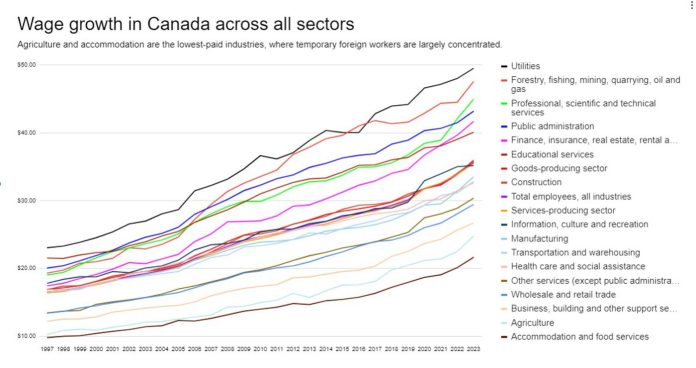
William Koblensky Varela, Local Journalism Initiative Reporter, New Canadian Media
Temporary immigration pathways are putting downward pressure on wage growth in Canada, but aren’t responsible for the country’s stagnating GDP per capita growth rate or the productivity rate, economists say.
While immigration does not normally suppress wages, economists agreed, temporary foreign workers entering the country over the last 18 months arrived when Canadian job vacancies were peculiarly high due to the pandemic.
“If you bring in people who have fewer rights than people with permanent status, then what that’s doing is creating downward pressure on wages,” Sheila Block, a research associate and former senior economist at the Canadian Centre for Policy Alternatives said.
Most temporary foreign workers are employed in the accommodation and agricultural industries, which are the lowest-wage sectors of the economy, according to Statistics Canada.
Employers don’t have an incentive to improve working conditions or raise wages when they have employees who can’t say “no” out of fear of workplace reprisals and are unlikely to find other employment, Block explained.
Block said both temporary foreign workers and low-wage immigrant workers who are in Canada permanently are facing negative effects from the short-term immigration pathway.
Until the middle of 2022, there was little evidence that immigration of any kind kept wages down, according to Pedro Antunes, chief economist at the Conference Board of Canada.
Antunes said temporary foreign worker programs have been successful at filling the enormous number of job vacancies after the pandemic, but the historic increase in immigration to fill those empty positions likely impacted established Canadians’ wages.
There were over one million unfilled jobs in May 2022, which fell to 637,365 by November 2023, according to Statistics Canada.
Higher unemployment rates coupled with more jobs getting filled has taken the pressure off labour markets, according to Antunes.
Unemployment has steadily increased since December 2022 and reached 5.8 per cent in February of this year, Statistics Canada data shows.
The Bank of Canada is likely relieved that the “vicious inflationary cycle” of higher wages outpacing inflation, giving way to even higher wages, was stopped, according to Antunes.
“We don’t know what the world would have been like without this strong immigration. We can only assess that it would have been a little bit different, probably tight labour markets and probably higher wage pressures overall,” Antunes said.
The non-permanent resident population increased to 2.2 million in 2023 from 1.5 million in 2022, according to Statistics Canada.
However, a high number of job vacancies don’t always equate to a labour shortage, according to Angella MacEwan, the senior economist at the Canadian Union of Public Employees (CUPE).
MacEwan said many long-term care employees aren’t being offered enough hours to make ends meet, and shifts that could go to employees with more stable status in Canada are instead being outsourced to temporary foreign workers.
There were 188,580 Temporary Foreign Worker program visa holders in Canada at the end of 2023, more than at the end of any other year since 2010, the most recent data from Statistics Canada shows.
The threat of deportation against temporary foreign workers divides them against employees who are permanently based in Canada and weakens pressure to increase wages, according to MacEwan.
MacEwan said immigration normally boosts the economy by filling labour market demands and increasing domestic spending, but temporary immigration prevents wage growth in some sectors.
“It’s not the fact that workers are being brought in, it’s the fact that they’re being brought in under a different set of rules,” MacEwan said.
Both MacEwan and Block argued lobbying from the business community has driven up the use of the Temporary Foreign Worker program to put downward pressure on wages, while Antunes declined to comment on lobbying activity.
Other streams for migrant workers include the International Mobility Program and international students, however, the Temporary Foreign Worker program ties migrant workers to one employer as a condition of staying in Canada.
Overall wage growth fell in December 2023 for the first time since February of last year, declining to $ 1,211.79 per week, Statistics Canada data shows.
Canada’s GDP grew by more over the past year than any other country in the G7, except for the United States, according to the OECD.
That growth rate happened in a year when 437,000 new permanent residents, along with over 604,000 temporary workers were accepted to the country, a report from Immigration Refugee and Citizenship Canada shows.
However, as the country’s population increased, Canada’s GDP per capita fell by 1.7 per cent.
A July 2023 Reuters article quoted economist David Rosenberg as saying Canada’s immigration boom had created a “mirage of economic prosperity” in GDP growth.
Economists who spoke to New Canadian Media said Canada’s slowing GDP per capita growth rate was not a reflection of immigration policies but gave a variety of reasons for the weaker indicator.
Immigrants take time to fully integrate into the economy, which explains rising GDP and slowing GDP per capita, explained Block, while temporary immigrants may never integrate into the economy.
Higher interest rates hitting business revenue is the cause for stalling GDP per capita figures, argued Antunes.
A low productivity rate driven by a lack of investment in innovation was another factor, said Antunes.
MacEwan suggested the price of oil and other commodities like potash were behind the GDP per capita numbers.
The Alberta Energy Regulator shows crude oil values sliding in 2023 from peaking in 2022.

